Looking back at 2013 (1/3): D-Day for the Human Brain project

© 2013 EPFL
During the first quarter of 2013, we decrypted the brain, made significant advances in the field of health, gained a deeper understanding into our Solar System, opened the doors to augmented reality and opened access to scientific publications, produced more efficient solar cells and developed an all-terrain technology.
Childhood trauma leaves its mark on the brain 15.01.13 - An EPFL team led by Professor Carmen Sandi, member of the National Centers for Competence in Research SYNAPSY, has demonstrated for the first time a correlation between psychological trauma and specific changes in the brain that are related to aggressive behavior. In rats, the experience of pre-adolescent trauma led to aggressive behavior accompanied by structural and functional changes in the brain – the same changes that have been observed in violent human beings. In other words, psychological wounds inflicted in childhood leave a lasting biological trace that persists in the adult brain. The team’s findings have been published in the January 15 edition of the journal Translational Psychiatry.
15.01.13 - An EPFL team led by Professor Carmen Sandi, member of the National Centers for Competence in Research SYNAPSY, has demonstrated for the first time a correlation between psychological trauma and specific changes in the brain that are related to aggressive behavior. In rats, the experience of pre-adolescent trauma led to aggressive behavior accompanied by structural and functional changes in the brain – the same changes that have been observed in violent human beings. In other words, psychological wounds inflicted in childhood leave a lasting biological trace that persists in the adult brain. The team’s findings have been published in the January 15 edition of the journal Translational Psychiatry.
The Human Brain Project Wins Top European Science Funding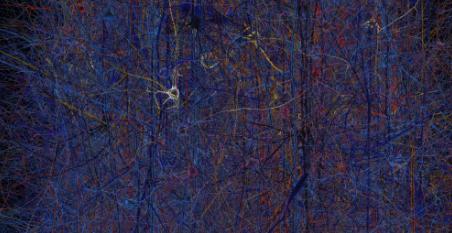 28.01.13 - The European Commission has officially announced the selection of the Human Brain Project (HBP) as one of its two FET Flagship projects. The new project will federate European efforts to address one of the greatest challenges of modern science: understanding the human brain and its diseases. The models offer the prospect of a new understanding of the human brain and of completely new computing and robotic technologies. Federating more than 80 European and international research institutions, the Human Brain Project is planned to last ten years (2013-2023). The cost is estimated at 1.19 billion euros. The project is coordinated at the EPFL by neuroscientist Henry Markram.
28.01.13 - The European Commission has officially announced the selection of the Human Brain Project (HBP) as one of its two FET Flagship projects. The new project will federate European efforts to address one of the greatest challenges of modern science: understanding the human brain and its diseases. The models offer the prospect of a new understanding of the human brain and of completely new computing and robotic technologies. Federating more than 80 European and international research institutions, the Human Brain Project is planned to last ten years (2013-2023). The cost is estimated at 1.19 billion euros. The project is coordinated at the EPFL by neuroscientist Henry Markram.
Slowing down microwaves in a chip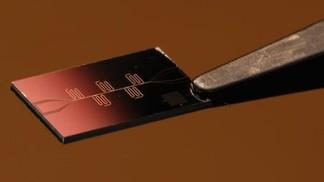 31.01.13 - Microwaves are ubiquitous: they are part of any cell phones or wireless routers. They are also used in navigation for airplanes and nowadays even in cars. The processing and management of microwave signals requires careful control over the way they propagate. Together with the Walther-Meissner-Institute in Garching Germany, researchers from the Laboratory of Photonics and Quantum Measurements led by Tobias Kippenberg have developed a new approach for harnessing the propagation of microwave signals. They have succeeded in capturing a microwave pulse within a chip for several milliseconds before releasing it with little loss. This extraordinary delay normally requires hundreds of miles of electrical cable, as well as amplifiers. Their conclusions are being published in Nature Physics.
31.01.13 - Microwaves are ubiquitous: they are part of any cell phones or wireless routers. They are also used in navigation for airplanes and nowadays even in cars. The processing and management of microwave signals requires careful control over the way they propagate. Together with the Walther-Meissner-Institute in Garching Germany, researchers from the Laboratory of Photonics and Quantum Measurements led by Tobias Kippenberg have developed a new approach for harnessing the propagation of microwave signals. They have succeeded in capturing a microwave pulse within a chip for several milliseconds before releasing it with little loss. This extraordinary delay normally requires hundreds of miles of electrical cable, as well as amplifiers. Their conclusions are being published in Nature Physics.
Doctoral student designs microphones that monitor road traffic 03.02.13 - Patrick Marmaroli PhD student from The Electromagnetics and Acoustics Lab (LEMA) has designed a dual microphone system that uses the sound produced when tires roll over pavement to determine traffic volume. The system can also track a vehicle’s speed and even determine its approximate size (i.e., whether a passing vehicle is a station wagon, compact, truck, etc). This information can then be used to provide traffic or air-pollution bulletins, and can also help engineers to better plan future road-building. It has already sparked an interest in the Swiss towns of Sion and Martigny.
03.02.13 - Patrick Marmaroli PhD student from The Electromagnetics and Acoustics Lab (LEMA) has designed a dual microphone system that uses the sound produced when tires roll over pavement to determine traffic volume. The system can also track a vehicle’s speed and even determine its approximate size (i.e., whether a passing vehicle is a station wagon, compact, truck, etc). This information can then be used to provide traffic or air-pollution bulletins, and can also help engineers to better plan future road-building. It has already sparked an interest in the Swiss towns of Sion and Martigny.
All-terrain technology for developing countries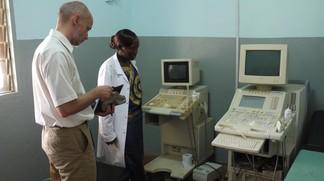 07.02.13 - EPFL is launching “EssentialTech,” a unique program in which engineers will in particular produce medical devices custom-designed for the difficult conditions encountered in developing countries. Equipment has a tough time in developing countries; the supply of electricity is unreliable, components are costly and fragile, and there is a lack of qualified personnel for maintenance. The EssentialTech program brings together companies and research institutions from north and south with the common goal of developing new technologies that are custom made for the needs of developing countries.
07.02.13 - EPFL is launching “EssentialTech,” a unique program in which engineers will in particular produce medical devices custom-designed for the difficult conditions encountered in developing countries. Equipment has a tough time in developing countries; the supply of electricity is unreliable, components are costly and fragile, and there is a lack of qualified personnel for maintenance. The EssentialTech program brings together companies and research institutions from north and south with the common goal of developing new technologies that are custom made for the needs of developing countries.
New world record efficiency for thin film silicon solar cells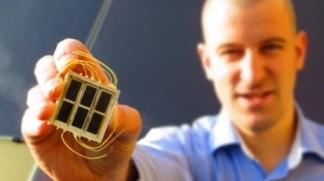 12.02.13 - EPFL’s Institute of Microengineering has reached a remarkable 10.7% efficiency single-junction microcrystalline silicon solar cell, clearly surpassing the previous world record of 10.1% held by the Japanese company Kaneka Corporation since 1998. Such significant efficiency, independently certified by the Fraunhofer Institute for Solar Energy Systems (ISE CalLab PV Cells), was achieved in addition with less than 2 micrometers of photovoltaic active material.
12.02.13 - EPFL’s Institute of Microengineering has reached a remarkable 10.7% efficiency single-junction microcrystalline silicon solar cell, clearly surpassing the previous world record of 10.1% held by the Japanese company Kaneka Corporation since 1998. Such significant efficiency, independently certified by the Fraunhofer Institute for Solar Energy Systems (ISE CalLab PV Cells), was achieved in addition with less than 2 micrometers of photovoltaic active material.
New York's reality augmented thanks to the EPFL + ECAL Lab 22.02.13 - For the first time, EPFL is the guest of the renowned Eyebeam Art and Technology Center in New York. Throughout more than 500 square meters, the EPFL + ECAL Lab will display its new works in augmented reality, where physical objects and digital representations are combined. This is a first for a Swiss institution. The place of honor goes to the Gimme More project, the Americanized version of the Give Me More exhibition, awarded the DMY International Design Festival prize in Berlin. Through the magic of technology, Gimme More’s premise is to transform simple everyday objects into a source of meaning and basis for a story.
22.02.13 - For the first time, EPFL is the guest of the renowned Eyebeam Art and Technology Center in New York. Throughout more than 500 square meters, the EPFL + ECAL Lab will display its new works in augmented reality, where physical objects and digital representations are combined. This is a first for a Swiss institution. The place of honor goes to the Gimme More project, the Americanized version of the Give Me More exhibition, awarded the DMY International Design Festival prize in Berlin. Through the magic of technology, Gimme More’s premise is to transform simple everyday objects into a source of meaning and basis for a story.
Open-access "made in EPFL" has caught Nature's publisher's eye 01.03.13 - Nature Publishing Group, publisher of the prestigious journal of the same name, has decided to invest in Frontiers, an EPFL-born company that publishes scientific journals under an open-access model. Frontiers has gradually become into one of the most prominent publishing companies in the world of open access (OA). Since its creation, the number of published articles has more than doubled per year. It now holds a portfolio of 14 open access journals in just as many scientific fields. Just to have an idea, it published over 5000 articles in 2012. The agreements made between nature.com and frontiersin.org will enable the publication of open access papers on both websites.
01.03.13 - Nature Publishing Group, publisher of the prestigious journal of the same name, has decided to invest in Frontiers, an EPFL-born company that publishes scientific journals under an open-access model. Frontiers has gradually become into one of the most prominent publishing companies in the world of open access (OA). Since its creation, the number of published articles has more than doubled per year. It now holds a portfolio of 14 open access journals in just as many scientific fields. Just to have an idea, it published over 5000 articles in 2012. The agreements made between nature.com and frontiersin.org will enable the publication of open access papers on both websites.
Fantastic flash memory combines graphene and molybdenite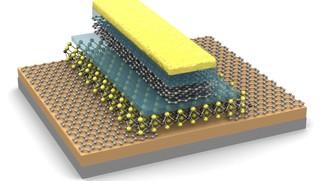 22.03.13 - EPFL scientists have combined two materials with advantageous electronic properties – graphene and molybdenite – into a flash memory prototype that is very promising in terms of performance, size, flexibility and energy consumption. Two years ago, the LANES team revealed the promising electronic properties of molybdenite (MoS2), a mineral that is very abundant in nature. Several months later, they demonstrated the possibility of building an efficient molybdenite chip. They’ve gone further still by using it to develop a flash memory prototype – that is, a cell that can not only store data but also maintain it in the absence of electricity.
22.03.13 - EPFL scientists have combined two materials with advantageous electronic properties – graphene and molybdenite – into a flash memory prototype that is very promising in terms of performance, size, flexibility and energy consumption. Two years ago, the LANES team revealed the promising electronic properties of molybdenite (MoS2), a mineral that is very abundant in nature. Several months later, they demonstrated the possibility of building an efficient molybdenite chip. They’ve gone further still by using it to develop a flash memory prototype – that is, a cell that can not only store data but also maintain it in the absence of electricity.
This new material has also the potential to improve the sensitivity of photographic image sensors by a factor of five. In 2011, an EPFL team led by Andras Kis discovered the amazing semi-conducting properties of molybdenite (MoS2), and they have been exploring its potential in various technological applications ever since.
 1
1 20.03.13 - EPFL scientists have developed a tiny, portable personal blood testing laboratory: a minuscule device implanted just under the skin provides an immediate analysis of substances in the body, and a radio module transmits the results to a doctor over the cellular phone network. This feat of miniaturization has many potential applications, including monitoring patients undergoing chemotherapy. This method will allow a much more personalized level of care than traditional blood tests can provide.
20.03.13 - EPFL scientists have developed a tiny, portable personal blood testing laboratory: a minuscule device implanted just under the skin provides an immediate analysis of substances in the body, and a radio module transmits the results to a doctor over the cellular phone network. This feat of miniaturization has many potential applications, including monitoring patients undergoing chemotherapy. This method will allow a much more personalized level of care than traditional blood tests can provide.